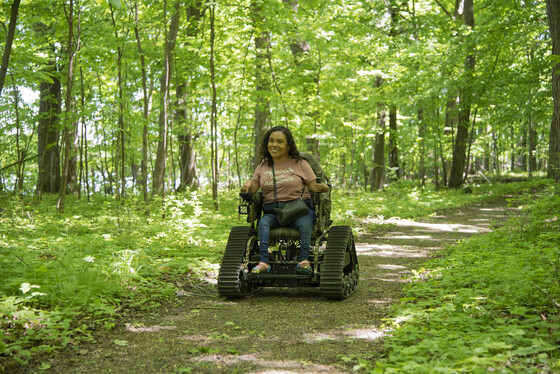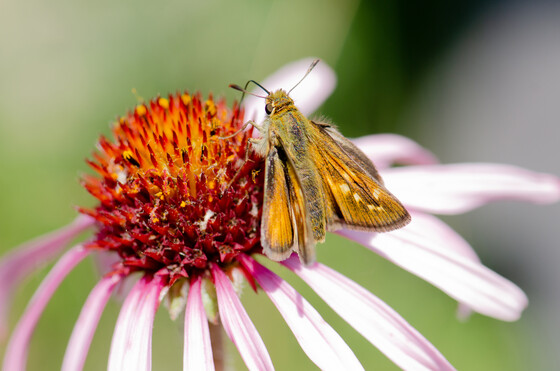In This Issue
A weekly list of news briefs about fish, wildlife, and habitat management.
Apply through Aug. 18 for special youth deer hunts
Hunters can apply for special youth deer hunt permits through Friday, Aug. 18. The number of permits for each hunt is limited. Individual hunts will be held in several state parks, and in the Rydell National Wildlife Refuge, on various dates in the fall. Adults must accompany youth during these hunts. These firearms hunts are for youth ages 12-15 at the time of the hunt.
Youth archery hunters in Sand Prairie Wildlife Management Area in Sherburne County can be ages 10-17.
Special youth deer hunts are different from the statewide youth deer season, which takes place Oct. 19-22 and does not require an application. More information is available on the DNR website (mndnr.gov/hunting/deer/special-deer-hunts.html).
In most instances, hunters may only possess and use nontoxic ammunition when participating in a special hunt in a Minnesota state park; however, nontoxic ammunition requirements do not apply to youth special hunts in the shotgun-use area if hunters remove all parts of harvested deer, including the entrails.
Nontoxic ammunition includes steel, copper-plated, nickel-plated, zinc-plated and other projectiles made from a nontoxic material approved by the U.S. Fish and Wildlife Service. A full list is available in the Code of Federal Regulations (ecfr.gov) and can be found by typing “hunting methods” in the search box and clicking “What hunting methods are illegal?”
Applications open for prairie chicken hunt lottery
Hunters can apply through Friday, Aug. 18, to be chosen for one of 125 permits for the 2023 Minnesota prairie chicken hunting season. The nine-day prairie chicken season begins Saturday, Sept. 23, and is open to Minnesota residents only. The hunt takes place in northwestern Minnesota from St. Hilaire south to Breckenridge. Hunters can find details about the season on the DNR website (mndnr.gov/hunting/prairiechicken).
Minnesota Twins offer free hats
Anyone with a 2023 Minnesota fishing or hunting license can receive a free special edition orange Minnesota Twins logo cap and a ticket discount from the Minnesota Twins, through a partnership between the Twins and the Minnesota Department of Natural Resources.
Upcoming DNR Days at Twins games this season are:
- Sunday, July 23 vs. Chicago White Sox, 1:10 p.m.
- Saturday, Aug. 19 vs. Pittsburgh Pirates, 6:10 p.m.
- Saturday, Sept. 9 vs. New York Mets, 1:10 p.m.
Promotion details, instructions for purchasing tickets, and information on buying a fishing or hunting license, are available on the Minnesota DNR Days webpage (mndnr.gov/twins). Tickets must be purchased ahead of time using a special DNR link (twins.com/dnr) to receive this offer.
DNR webinars cover falconry, frogs and toads
The Minnesota Department of Natural Resources invites people interested in wildlife and outdoor skills to check out the summer program schedule for the Minnesota Outdoor Skills and Stewardship Series.
In a webinar on Wednesday, July 19, Matt Lasch will discuss falconry and how to hunt with these amazing birds. The presentation will include a brief history of falconry, steps to becoming a falconer, birds typically used in falconry, and the training and hunting process. Lasch will also briefly cover how falconers have been critical in several conservation and restoration efforts.
In a webinar on Wednesday, July 26, Mags Edwards, DNR frog and toad research program coordinator, will discuss why frogs and toads are unlikely ambassadors for environmental conservation. Edwards will also share tips to identify different frog and toad species, and how people can go “herping” with a purpose to help the DNR collect information about frogs and toads in Minnesota.
The Minnesota Outdoor Skills and Stewardship Series webinars are free and offered year-round, though registration is required. Visit the Outdoor Skills and Stewardship webpage of the DNR website (mndnr.gov/discover) for the registration portal, more information about upcoming webinars and recordings of past webinars.
###
All-terrain track chairs expand access to state parks for visitors with mobility disabilities
 Photo credit: Minnesota DNR
The Minnesota Department of Natural Resources is expanding its all-terrain track chair program by bringing the adaptive mobility devices to eight additional state parks.
The DNR launched the program in 2022 with five all-terrain track chairs. By Aug. 1, 2023, there will be 13 chairs available at state parks throughout the state. The battery-powered chairs enable visitors with mobility disabilities to explore trails and other areas within state parks that can’t be accessed using a regular wheelchair.
“Like all our public lands and waters, Minnesota state parks are for everyone to enjoy,” said DNR Commissioner Sarah Strommen. “I’m thrilled that current efforts and future investments will allow more people to enjoy the outdoor spaces that make our state a great place to live, work, and play. These track chairs represent the type of investment DNR will make over the next several years thanks to historic legislative funding for our Get out MORE (Modernize Outdoor Recreation Experiences) initiative, which aims to ensure Minnesotans of all abilities and interests enjoy world-class outdoor experiences.”
Track chairs will be newly available this summer at Blue Mounds, Father Hennepin, Fort Snelling, Frontenac, Itasca, Lake Carlos, McCarthy Beach and Split Rock Lighthouse state parks. These eight parks join the parks that got chairs in 2022 – Camden, Crow Wing, Lake Bemidji, Maplewood and Myre-Big Island. Parks were selected based on a number of factors, including the presence of trails suitable for track chair use, availability of storage space and charging outlets near a trailhead, and the desire to locate track chairs broadly throughout the state.
“The research is clear: spending time in nature provides significant health and wellness benefits for people,” said DNR Parks and Trails Director Ann Pierce. “Investing in adaptive equipment like the all-terrain track chairs helps the DNR connect more Minnesotans with the outdoors by providing experiences they may not have without a track chair.”
Visitors can call a park with a track chair ahead of time to reserve that chair. There is no cost to use an all-terrain track chair, but visitors will need a state park vehicle permit. Minnesota residents who qualify for disability parking can get a reduced rate year-round vehicle permit for $12. To learn more, visit the Minnesota DNR’s state park permit webpage (mndnr.gov/permit).
In addition to the 13 state parks offering all-terrain track chairs, McCarthy Beach State Park offers an adaptive beach chair, which enables visitors with disabilities to enjoy a one-of-a-kind swimming beach experience within a state park setting. McCarthy Beach also offers a beach mat, which goes over the sandy beach and helps people with mobility disabilities get to the waterfront.
For more information, including phone numbers for the state parks offering track chairs and other adaptive equipment, visit the Minnesota DNR’s track chair webpage (mndnr.gov/state_parks/track-chairs.html).
###
 Photo credit: Minnesota DNR
The Minnesota Department of Natural Resources and the Minnesota Zoo recently released hundreds of Dakota skipper butterflies back to the prairie at Glacial Lakes State Park.
“Dakota skippers were once common at Glacial Lakes State Park, but we haven’t seen them at the park since 2005,” said Cindy Lueth, DNR Parks and Trails northwest regional resource management supervisor. “Many hours and a variety of tools have been used to prepare the native landscape for the Dakota skipper reintroduction. We are thrilled to welcome back this endangered butterfly.”
Once common throughout much of Minnesota’s native tallgrass prairie, Dakota skippers have since vanished from nearly all sites in the state. It is now listed as an endangered species in Minnesota and threatened in the U.S.
The Dakota skipper can only survive in native prairie habitat and does not inhabit non-native grasslands, weedy roadsides, tame hay land or other habitats that are not remnant native prairie. Today, approximately 1% of native prairie remains in the state.
The Minnesota DNR’s Parks and Trails resource crew in the northwest region has been enhancing remnant native prairie sites at Glacial Lakes State Park for the reintroduction effort since 2018. Park staff harvested and planted seed from native prairie vegetation and hand-planted thousands of narrow-leaved purple coneflower, a preferred nectar source of the skipper. The crew removed more than 250 acres of woody vegetation, conducted prescribed burns and has now introduced grazing as one of the tools used to manage prairie habitat for the butterfly.
The Minnesota Zoo, the DNR’s Parks and Trails Division, the U.S. Fish and Wildlife Service and The Nature Conservancy developed a unique conservation research partnership to help save the Dakota skipper and other Minnesota endangered prairie butterflies. Funding has been provided by the Minnesota Environment and Natural Resources Trust Fund, as recommended by the Legislative-Citizen Commission on Minnesota Resources and the Parks and Trails Legacy Fund.
“Helping these butterflies return to our prairies supports not only other wildlife but our quality of life,” said Dr. Erik Runquist, butterfly biologist at the Minnesota Zoo. “Our hope is to continue to build on successes and re-establish populations throughout the region.”
The Minnesota Zoo’s Pollinator Conservation Initiative (mnzoo.org/conservation/minnesota/saving-minnesotas-prairie-butterfly-heritage/) created the world’s first rearing and breeding programs for Dakota skipper (and Poweshiek skipperling) to help save those butterfly species from extinction.
The zoo rears hundreds of Dakota skippers annually in its facility, then releases and monitors those individuals to help re‐establish lost populations. Zoo biologists also study wild populations of prairie butterflies and their habitats to assess their status and the threats they face.
“The initiative began in 2012 and has conducted ground-breaking work over the past several years to secure a future for our state’s most imperiled pollinator species,” said Cale Nordmeyer, butterfly conservation specialist at the Minnesota Zoo. “Along with our partners, we are doing vital work for some of the most endangered butterfly species in the world.”
Glacial Lakes State Park was established in 1963 to preserve the rolling prairies of the area, the comparatively pristine condition of the land, and its rich prairie flora. It is home to 69 different species of animals designated as those of Greatest Conservation Need — most are associated with the prairie habitat.
Learn more about this project on the Minnesota DNR website (mndnr.gov/state_parks/dakota-skipper-reintroduction.html) and more about the Dakota skipper at the USFWS website (fws.gov/species/dakota-skipper-hesperia-dacotae).
###
|
